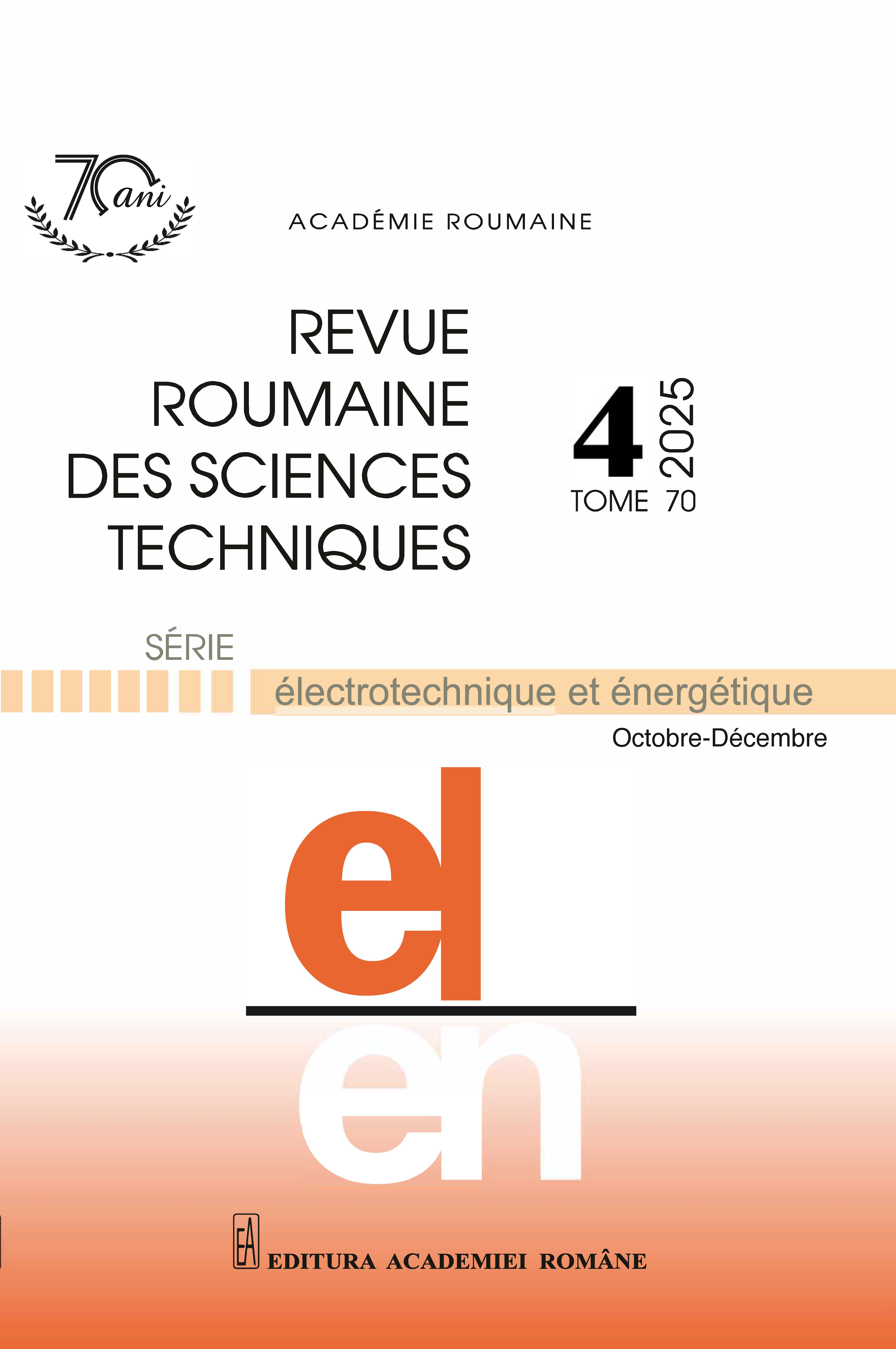INFORMATION SYSTEM DEVELOPMENT OF ELECTRIC CAR CHARGING STATIONS BY UNIFIED MODELLING LANGUAGE DIAGRAMS
DOI:
https://doi.org/10.59277/RRST-EE.2025.4.21Keywords:
Information system, Electric car charging stations, Process layer supply, Unified modelling language (UML)Abstract
This paper presents a high-level approach to developing an information system for electric car charging stations, utilizing a Process Layer Supply pattern. This pattern organizes activity processes, business rules, visions, and goals that support system modelling. The paper models the system's structural and behavioral aspects using UML diagrams—specifically, class, use case, and activity diagrams — via the Papyrus UML2 tool. These diagrams facilitate visualizing functional requirements, user-to-system interactions, and system components for efficient planning, development, and implementation. The model addresses the most critical gaps in an electric car charging infrastructure and optimizes the information system's operations for practical implementation. The proposed system is designed to support future developments, like integration with dynamic demand markets for flexible pricing and optimized operations. Additionally, we use pseudocode to link abstract UML models to actual implementations, ensuring the accurate transfer of system logic to the corresponding code. Since every component of the charging network is logically interconnected, a sustainable foundation for future electric car mobility is established.
References
(1) T. Živojinović, N. Bojković, and S. Kaplanović, Evropski zeleni dogovor i transport: ciljevi i mere ka održivosti, ECOLOGICA, 30, 111, pp. 1–408 (2023).
(2) M. Milošević, D. Milošević, and V. Dimić, Application of fuzzy AHP approach for designing model of smart city development, In M. Gligorijević (Editor in chief), Smart Cities and Modern Technologies, ALFATECH, Belgrade, Serbia, pp. 13–24 (2024).
(3) Z. Đurić and B. Ilić, Systemic environmental protection and determinants of sustainable management, An Open Acc. Jour. Fores. and Envir., POPLAR, 211, pp. 45–57 (2023).
(4) V. Dimić, M. Milošević, D. Milošević, and D. Stević, Adjustable model of the renewable energy project for sustainable development: A case study of the Nisava District in Serbia, Sustainability, 10, 3, 775 (2018).
(5) P. Shankar, B. Morkos, D. Yadav, and J.D. Summers, Towards the formalization of non-functional requirements in conceptual design, Research in Engineering Design, 31, pp. 449–469 (2020).
(6) D. Amyot, Introduction to the User Requirements Notation: Learning by Example, Computer Networks, 42, 3, pp. 285–301 (2003).
(7) M.I. Oproiu and C.V. Marian, Virtual reality system - use case scenario for post-traumatic stress disorder symptoms treatment, Rev. Roum. Sci. Techn. – Électrotechn. et Énerg., 69, 4, pp. 449–454 (2024).
(8) M. Clemente, M.P. Fanti, G. Iacobellis, and W. Ukovich, Modeling and simulation of an electric car sharing system, A.G. Bruzzone (Ed.), European Modeling and Simulation Symposium, EMSS, Athens, Greece, pp. 587–592 (2013).
(9) M. Kumar, K.P. Panda, R.T. Naayagi, R. Thakur, and G. Panda, Comprehensive review of electric vehicle technology and its impacts: detailed investigation of charging infrastructure, power management, and control techniques, Applied Science, 13, 15, 8919 (2023).
(10) B. Koodalsamy, V. Narayanaswamy, K. Krishnamoorthy, and B. Ananthan, Implementation of Vienna rectifier with sliding mode control for electric vehicle charging stations, Rev. Roum. Sci. Techn. – Électrotechn. et Énerg., 69, 4, pp. 425–430 (2024).
(11) H. Lin, C. Bian, Y. Wang, H. Li, Q. Sun, and F. Wallin, Optimal planning of intra-city public charging stations, Energy, 238, Part C, 121948 (2022).
(12) M.S. Mastoi, S. Zhuang, H.M. Munir, M. Haris et al., An in-depth analysis of electric vehicle charging station infrastructure, policy implications, and future trends, Energy Reports, 8, 1, pp. 11504–11529 (2022).
(13) J. Liu, Electric vehicle charging infrastructure assignment and power grid impacts assessment in Beijing, Energy Policy, 51, pp. 544–557 (2012).
(14) X. Zhang, The Design of Electric Vehicle Charging Network, M.Sc. Thesis, McMaster University, Hamilton, Ontario, Canada (2015).
(15) T. Unterluggauer, J. Rich, P.B. Andersen, and S. Hashemi, Electric vehicle charging infrastructure planning for integrated transportation and power distribution networks: A review, eTransportation, 12, 100163 (2022).
(16) S.A. Funke, F. Sprei, T. Gnann, and P. Plötz, How much charging infrastructure do electric vehicles need? A review of the evidence and international comparison, Transportation Research Part D: Transport and Environment, 77, 7, pp. 224–242 (2019).
(17) D. Müller-Eie and I. Kosmidis, Sustainable mobility in smart cities: a document study of mobility initiatives of mid-sized Nordic smart cities, Eur. Transp. Res. Rev., 15, 1 (2023).
(18) S. Maase, X. Dilrosun, M. Kooi, and R. Van den Hoed, Performance of Electric Vehicle Charging Infrastructure: Development of an Assessment Platform Based on Charging Data, World Electr. Veh. J., 9, 2, 25 (2018).
(19) P. Wang, Q. Zhang, J. Dai, S. Wang, and H.H. Cai, Integration needs and challenges for green and smart transformation of port industry based on multi-source data, Rev. Roum. Sci. Techn. – Électrotechn. et Énerg., 69, 1, pp. 73–78 (2024).
(20) U.E. Hanni, T. Yamamoto, and T. Nakamura, Modeling of the acceptable waiting time for EV charging in Japan, Sustainability, 16, 6, 2536 (2024).
(21) A. Lupasc, Use of unified modeling language in the development of object-oriented information systems, Annals of “Dunarea de Jos” University of Galati Fascicle I, Economics and Applied Informatics, 28, 3, pp. 51–56 (2021).
(22) T. Górski, UML Profile for messaging patterns in service-oriented architecture, microservices, and Internet of Things, Appl. Sci., 12, 24, 12790 (2022).
(23) V. Dimić and P. Milošević, Modeling mobility performance within smart city infrastructure using URN diagrams, In Dj. Jovanović (Editor-in-Chief), Advances in Science and Technology, COAST, Herceg Novi, Montenegro, pp. 282–290 (2024).
(24) K. Stančin, Model sustava za predlaganje digitalnih obrazovnih igara za učenike s teškoćama, Zbornik Veleučilišta u Rijeci, 12, 1, pp. 145–161 (2024).
Downloads
Published
Issue
Section
License
Copyright (c) 2025 REVUE ROUMAINE DES SCIENCES TECHNIQUES — SÉRIE ÉLECTROTECHNIQUE ET ÉNERGÉTIQUE

This work is licensed under a Creative Commons Attribution-NonCommercial-NoDerivatives 4.0 International License.


